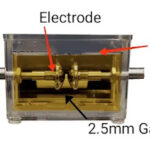Auto transformer is a transformer in which part of the winding is common to both the primary winding circuit and a secondary winding. In normal two winding transformers, primary and secondary winding are electrically isolated but in the case of an autotransformer, the two winding are connected electrically as well as magnetically.
Auto transformer are also called variac or variable autotransformer. Auto transformer works as a voltage regulator. With the help of autotransformer, we can get variable voltage at the output.

The above diagram (a) shows the connection diagram of step down auto-transformer and figure (b) shows the connection diagram of step-up autotransformer.

In both cases step up and step down, the winding “ab” having N1 turns is a primary winding circuit, and winding “bc” having N2 turns is the secondary winding of the auto transformer.
Note that the primary and secondary winding of auto transformer are connected electrically as well as magnetically.
Hence Power from the primary is transferred to the secondary winding conductively as well as Transformer action by mutual induction.
The above diagram depicts the connections of the loaded step-down and step-up autotransformer. In both cases, I1 is the input current and I2 is the output current, Regardless of Step Up/Stepdown autotransformer, the current in the section of winding that is common to both the primary and secondary is the difference between these two currents I1 and I2.
The direction of the current through the common part of the winding depends upon the connection of the autotransformer. because the type of connection decides whether input current I1 or output current I2 is larger.
For a step-down type I2 > I1 so I2– I1 current flows through the common part of the winding. For step Up autotransformer I2 < I1 hence I1– I2 current flows in the common part of the winding.
Theory of auto transformer Working

The diagram shows an ideal step down autotransformer with load, hence primary winding 1-3 having N1 turns and secondary winding 2-3 having N2 turns.
The input current is I1 while output current is shown with I2, in the diagram primary winding portion 1-2 has N1-N2 turns and the voltage across the primary winding part is V1-V2, the current through the common part of the winding is I2– I1 diagram 2 shows an equivalent circuit of the autotransformer.
From the equivalent circuit,

V1I1 = V2I2 (Input apparent power = Output apparent power)
Output
The primary and secondary windings of auto transformer are connected magnetically as well as electrically, the power transfer from the primary circuit to the secondary is in the form of induction as well as conduction.
Output Apparent power=V2I2
Apparent power transfer by induction=V2(I2 – I1) =V2(I2 – kI2)
=V2I2(1- k)=V1I1(1- k)
Power transfer inductively = Input *(1- k)
Power transfer Conductively=I/p- I/p(1- k)
=I/p [ 1- (1-k)]
=I/p * k
Copper saving
For the same output and voltage transformation, an autotransformer required less copper transformer required less copper than an an ordinary transformer in first diagram ordinate transformer is depicted and the second diagram shows at a transformer having the same output and voltage transformation ratio k
The length of copper required in autotransformer winding is directly proportional to the turns, and the area of cross-section of the winding wire is proportional to the current rating of the auto transformer, therefore, copper required for winding is proportional to the current X turn.
Weight of copper in autotransformer winding ∝ Current x Turn
Winding transformer
Weight of copper required ∝ I1N1 +I2 N2
Autotransformer
Weight of copper required in section 1-2 ∝ I1 (N1 – N2)
Weight of copper required in section 2 -3 ∝ N2 (I2 – I1)
therefore,
Total weight of Cu required ∝ I1 (N1 – N2) +N2(I2 – I1)

Weight of Cu in autotransformer (Wa) = (1 – K) x Wt. in ordinary transformer (Wo)
Wa = (1 – K) x Wo
Saving in Copper = Wo – Wa = Wa – (1 – K)Wo = K Wo
or
Saving in Copper = K ´ Wt. of Cu in ordinary transformer
Thus if K = 0.1, the saving of Cu is only 10% but if K = 0.9, saving of Cu is 90%. Therefore, the nearer the value of K of autotransformer is to 1, the greater is the saving of Copper.
Advantages
- An autotransformer required less Copper than an ordinary transformer of a similar rating.
- It has better voltage regulation and operates at a higher efficiency than a 2-winding transformer of the same rating.
- It has a smaller size than an ordinary transformer of the same rating.
- An autotransformer requires a smaller exciting current than a 2-winding transformer of the same rating.
It may be noted that these advantages of the autotransformer decrease as the ratio of transformation increases. Therefore, an autotransformer has marked advantages only for relatively low values of transformation ratio
Disadvantages
Some disadvantages autotransformer are given as follows
- There is a direct connection between the primary winding and the secondary. Therefore, the output is no longer directly isolated from the input.
- An autotransformer is not safe for stepping down a high voltage to a low voltage. in case an open circuit develops in a common part of winding then full primary voltage appears across the load, it will be dangerous to both people and equipment.
- The short-circuit current is much larger than for the two-winding transformer of the same rating.
Applications
- Autotransformers are used to compensate for voltage drops in transmission lines. When used for this application, these are known as booster transformers.
- It is also used as a reduced voltage starter for the Induction motor.
- Autotransformers are used to obtain a variable supply.
Related.
